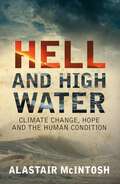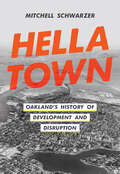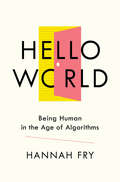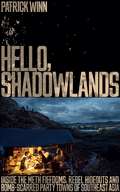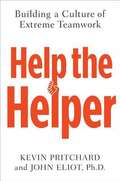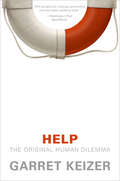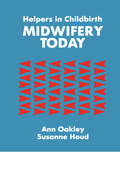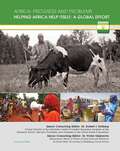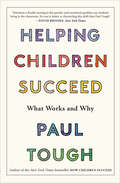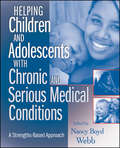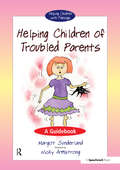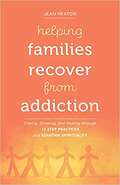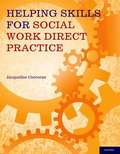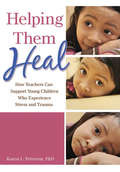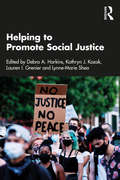- Table View
- List View
Hell and High Water: Climate Change, Hope and the Human Condition
by Alistair McIntoshThe ecologist and author of Soil & Soul makes a compelling and provocative argument for a new way of life in the face of climate change. Climate change is the greatest challenge that the world has ever faced. In this groundbreaking book, Alastair McIntosh summarizes the science of what is happening to the planet using his home country of Scotland as a case study. He then argues that the root of our climate crisis is not in our politics but in our consumerism—an addictive mentality where wants have replaced needs and consumption drives our very identity. In a fascinating journey through literature that speaks to climate change—including the ancient Sumerian Epic of Gilgamesh, Plato's myth of Atlantis, and Shakespeare's Macbeth—McIntosh reveals the psychohistory of modern consumerism. He shows how we have fallen prey to a numbing culture of violence and the manipulation of marketing. Only when we resist these vices and face reality will we discover the spiritual meaning of our troubled times. Only then can magic, new meaning, and all that gives life, start to mend a broken world. &“What [McIntosh] does brilliantly here is offer an alternative, deeply humanist version of green politics.&” —The Scotsman, UK
Hella Town: Oakland's History of Development and Disruption
by Mitchell SchwarzerHella Town reveals the profound impact of transportation improvements, systemic racism, and regional competition on Oakland’s built environment. Often overshadowed by San Francisco, its larger and more glamorous twin, Oakland has a fascinating history of its own. From serving as a major transportation hub to forging a dynamic manufacturing sector, by the mid-twentieth century Oakland had become the urban center of the East Bay. Hella Town focuses on how political deals, economic schemes, and technological innovations fueled this emergence but also seeded the city’s postwar struggles. Toward the turn of the millennium, as immigration from Latin America and East Asia increased, Oakland became one of the most diverse cities in the country. The city still grapples with the consequences of uneven class- and race-based development-amid-disruption. How do past decisions about where to locate highways or public transit, urban renewal districts or civic venues, parks or shopping centers, influence how Oaklanders live today? A history of Oakland’s buildings and landscapes, its booms and its busts, provides insight into its current conditions: an influx of new residents and businesses, skyrocketing housing costs, and a lingering chasm between the haves and have-nots.
Hellenismos: Practicing Greek Polytheism Today
by Tony MierzwickiHeed the Call of the Greek Gods and GoddessesThe religion of the ancient Greeks has lain dormant for too long. In Hellenismos, Tony Mierzwicki shows how to bring it back in all of its primal glory. Learn how to forge personal relationships with the ancient Greek deities. Recreate the practices of the Greeks and enjoy the richness of their spiritual practices. Explore this accessible introduction to Greek reconstruction and discover:Ancient Greek history and cultureDeities, Daimones, and HeroesSimple daily observances and personal practiceThe lunar cycle and festival observancesControversial issues regarding Greek reconstructionPraise:"I, for one, welcome Tony Mierzwicki's marvelous work, Hellenismos. In a single volume, it not only fills a vacuum in my education, it clearly and concisely provides fascinating insights into a world to which we are all indebted—a world of gods, and heroes, and spirits, and magick, and all that is great, judicious, and distinct in the western soul."—Lon Milo DuQuette, author of Homemade Magick and Low Magick"Communion with the gods is grounded in everyday practice. Hellenismos provides the reader with the necessary tools to quickly enter into Pagan Greek religion. The book combines an accurate historical understanding with practices updated for today's needs."—Brandy Williams, author of For the Love of the Gods and The Woman Magician"Mierzwicki has succeeded in combining fine scholarship with deep vision to provide the reader with a comprehensive overview of Grecian polytheistic theory and practice. His offering brings to life an ancient tradition made relevant for modern times."—Kristoffer Hughes, author of The Book of Celtic Magic, From the Cauldron Born, and The Journey Into Spirit"Hellenismos is an excellent guide to practicing ancient Greek polytheism. Advancing from daily, personal practices, to the sacred lunar month, and finally to the annual festival cycle, Tony gently draws the reader deeper into Hellenic polytheism."—John Opsopaus, author of The Oracles of Apollo and The Pythagorean Tarot"Hellenismos makes an open and shut case for the need to modify the ancient Greek religion to suit the modern world, rather than recreating it faithfully...The author provides a wonderful guide to crafting your own personal path of venerating the ancient Greek gods and goddesses while remaining true to the spirit of the time."—Karen Tate, author of Walking An Ancient Path"In Hellenismos author Tony Mierzwicki provides an invaluable resource for both novice and experienced practitioners of ancient Greek religion...With instructions for holding daily, monthly, and annual observances, this book is nothing less than a toolkit for building your personal Hellenic path."—Alaric Albertsson, author of A Handbook of Saxon Sorcery and Magic and To Walk a Pagan Path
Hello World: Being Human in the Age of Algorithms
by Hannah FryShortlisted for the 2018 Royal Society Investment Science Book Prize A look inside the algorithms that are shaping our lives and the dilemmas they bring with them. If you were accused of a crime, who would you rather decide your sentence—a mathematically consistent algorithm incapable of empathy or a compassionate human judge prone to bias and error? What if you want to buy a driverless car and must choose between one programmed to save as many lives as possible and another that prioritizes the lives of its own passengers? And would you agree to share your family’s full medical history if you were told that it would help researchers find a cure for cancer? These are just some of the dilemmas that we are beginning to face as we approach the age of the algorithm, when it feels as if the machines reign supreme. Already, these lines of code are telling us what to watch, where to go, whom to date, and even whom to send to jail. But as we rely on algorithms to automate big, important decisions—in crime, justice, healthcare, transportation, and money—they raise questions about what we want our world to look like. What matters most: Helping doctors with diagnosis or preserving privacy? Protecting victims of crime or preventing innocent people being falsely accused? Hello World takes us on a tour through the good, the bad, and the downright ugly of the algorithms that surround us on a daily basis. Mathematician Hannah Fry reveals their inner workings, showing us how algorithms are written and implemented, and demonstrates the ways in which human bias can literally be written into the code. By weaving in relatable, real world stories with accessible explanations of the underlying mathematics that power algorithms, Hello World helps us to determine their power, expose their limitations, and examine whether they really are improvement on the human systems they replace.
Hello, Cutie!
by Pamela KlaffkeA doe-eyed doll, a smiley-faced cupcake, a sweet plush kitten: they're cute?and cute is at the heart of a growing legion of adult collectors and enthusiasts who live and breathe all things cuddly and adorable.Journalist and writer Pamela Klaffke, author of Spree: A Cultural History of Shopping and herself an avid collector of cute since she was a child, takes readers on a rainbow-and-unicorn-filled journey through cute culture, from its origins in Japan where teenaged girls help drive the "cute" economy, to its modern-day manifestations in the bubblegum-colored careers of performers like Katy Perry. The book also delves into the fanatical world of cute creators and collectors, the psychology of nostalgia, and the phenomenon known as creepy/cute. There's also cute food, anthropomorphized animals, and cute superstars such as Blythe, My Little Pony, and Hello Kitty herself. Full-color throughout, the book also includes many photographs of cute objects from the author's extensive personal collection.As charming and captivating as its subject matter, Hello, Cutie! invites readers to indulge their cuddliest guilty pleasures. It's as cute as can be!Pamela Klaffke is the author of Spree: A Cultural History of Shopping.
Hello, Shadowlands: Inside the Meth Fiefdoms, Rebel Hideouts and Bomb-Scarred Party Towns of Southeast Asia
by Patrick Winn<p>Essential to understanding Southeast Asia in the 21st century, Hello, Shadowlands reveals a booming underworld of organised crime across a region in flux― a $100 billion trade that deals in narcotics, animals and people ―and the staggering human toll that is being steadily ignored by the West. <p>From Myanmar’s anarchic hills to the swamplands of Vietnam, jihadis are being pitted against brothel workers, pet thieves against vigilantes and meth barons against Christian vice squads. <p>Hello, Shadowlands takes a deep plunge into crime rings both large and small. It also examines how China’s rise and America’s decline is creating new opportunities for transnational syndicates to thrive. <p>Focusing on human stories on both sides of this crime wave, the acclaimed Bangkok-based broadcaster and journalist Patrick Winn intimately profiles the men and women of the region who are forced to make agonizing choices in the absence of law.</p>
Hello, Startup
by Yevgeniy BrikmanThis book is the "Hello, World" tutorial for building products, technologies, and teams in a startup environment. It's based on the experiences of the author, Yevgeniy (Jim) Brikman, as well as interviews with programmers from some of the most successful startups of the last decade, including Google, Facebook, LinkedIn, Twitter, GitHub, Stripe, Instagram, AdMob, Pinterest, and many others.Hello, Startup is a practical, how-to guide that consists of three parts: Products, Technologies, and Teams. Although at its core, this is a book for programmers, by programmers, only Part II (Technologies) is significantly technical, while the rest should be accessible to technical and non-technical audiences alike.If you're at all interested in startups--whether you're a programmer at the beginning of your career, a seasoned developer bored with large company politics, or a manager looking to motivate your engineers--this book is for you.
Hello, Startup: A Programmer's Guide to Building Products, Technologies, and Teams
by Yevgeniy BrikmanThis book is the "Hello, World" tutorial for building products, technologies, and teams in a startup environment. It's based on the experiences of the author, Yevgeniy (Jim) Brikman, as well as interviews with programmers from some of the most successful startups of the last decade, including Google, Facebook, LinkedIn, Twitter, GitHub, Stripe, Instagram, AdMob, Pinterest, and many others.Hello, Startup is a practical, how-to guide that consists of three parts: Products, Technologies, and Teams. Although at its core, this is a book for programmers, by programmers, only Part II (Technologies) is significantly technical, while the rest should be accessible to technical and non-technical audiences alike.If you’re at all interested in startups—whether you’re a programmer at the beginning of your career, a seasoned developer bored with large company politics, or a manager looking to motivate your engineers—this book is for you.
Help Them Grow or Watch Them Go, Third Edition: Career Conversations Organizations Need and Employees Still Want
by Beverly Kaye Julie Winkle GiulioniThis new edition of the bestselling employee development classic includes advice on engagement and retention in today's more flexible employment environment, a new chapter on remote and hybrid work, and a deeper discussion of career development in your organization.Study after study confirms that career development is the single most powerful tool managers have for driving retention, engagement, productivity, and results. But most managers feel they just don't have time for it. This book offers a better way: frequent, short conversations with employees about themselves, their goals, and the business that can be integrated seamlessly into the normal course of business.Beverly Kaye and Julie Winkle Giulioni identify three broad types of conversations that will increase employees' awareness of their strengths, weaknesses, and interests; and point out where their organization and their industry are headed. The authors provide new assessments, worksheets, and a discussion guide to help employees and managers pull all of that together to create forward momentum. The accompanying AI Bookbot enhances this experience by offering real-time guidance, conversation prompts, and personalized insights based on the book's proven methodologies.
Help for Today: How to Achieve Security by Using the Power Within You
by Ernest HolmesThis book by Dr. Ernest Holmes, the Founder of the Religious Science Movement, and Dr. William Hornaday, of the same faith and one of the most popular ministers of our country today, passes the ammunition. It teaches a definite, specific Practice of the Power of God. Here is ammunition for the people of this country and this year, as modern as guided missiles, as far-reaching as rockets to the moon. Founded as all science must be, upon Truth which changes not, it is a new revelation of the God-Power, the Higher-Power that has always been available to man.“IN this book there is a vital answer to the demand many of us have been making upon the spiritual leadership of our times.‘Please,” we have been saying, ‘pass the ammunition.’Because today we are in the midst of the greatest battle mankind has ever known. In this fight for world supremacy, we stand opposed to any power which declares that it is without faith in any God at all.No longer can a spiritual faith stand without works. We will not settle now, cannot settle now, for uplifting quotations and tenets and creeds that have nothing to do with real life and its present startling advances in material science, its cold wars and constant threats.We must now use the POWER that is latent in our spiritual science. We must now learn how to make it work.PASS THE AMMUNITION!
Help the Helper: Building a Culture of Extreme Teamwork
by John Eliot Kevin Pritchard“The real lessons of teamwork don’t happen on camera. They happen behind the closed doors of locker rooms and team meetings and practice facilities. Kevin and John open those closed doors. All you need to do is get reading!” —Larry Bird “Help the helper” is a basketball motto preached by some of the sport’s legendary coaches, including Dean Smith and Phil Jackson. All good players know they should support a teammate who’s under pressure. But the true greats know how to take it one step further. They fill the gaps left behind when one teammate goes to help another—gaps that are often far from the basket and out of the spotlight. The true greats step up in quiet ways to make sure no subtle holes develop on defense and no opportunities are missed on offense. Help the Helper will show you how to put this level of teamwork to work in your business, to build a culture that recognizes and rewards those who help the helper—even when they don’t have sexy statistics. In the process, it will teach you how to de-emphasize the CEO/quarterback/superstar and effectively redefine leadership. You’ll learn, for instance, how to: Create a dynasty of unselfishness. Manage energy, not people. Eat obstacles for breakfast. Act like an “unleader. ” Consider how it works in the hospitality industry. In a great restaurant you don’t have to wait for your server to check on you; your needs are taken care of instantaneously, sometimes before you notice them. Everyone from the busboy to the maître d’ has one goal: the success of the team. Such coordination seems complicated for a small eatery, nearly impossible for a large organization. But it’s easier than you think. For a combined forty years, Pritchard and Eliot have focused on building high-performing groups. They’ve crushed Malcolm Gladwell’s 10,000-Hour Rule, logging upward of 50,000 hours studying the factors that create champions and dynasties, from the NBA and Major League Baseball to the Fortune 500. Exhaustive testing, scouting, and evaluating have taught them that truly special teams in all fields have one common denominator: a willingness to do whatever it takes to help the helper. Drawing on true and inspirational stories from sports to medicine to business, Help the Helper shows what’s behind the curtain that fuels great team performance. .
Help: The Original Human Dilemma
by Garret KeizerIn a book the San Francisco Chronicle called "unclassifiably wise" and a "masterpiece," noted Harper's essayist Garret Keizer explores the paradox that we are human only by helping others– and all too human when we try to help. It is the primal cry, the first word in a want ad, the last word on the tool bar of a computer screen. A song by the Beatles, a prayer to the gods, the reason Uncle Sam is pointing at you. What we get by with a little of, what we could use a bit more of, what we were only trying to do when we were so grievously misunderstood. What we'll be perfectly fine without, thank you very much. It makes us human. It can make us suffer. It can make us insufferable. It can make all the difference in the world. It can fall short. "Help is like the swinging door of human experience: 'I can help!' we exclaim and go toddling into the sunshine; 'I was no help at all,' we mutter and go shuffling to our graves. I'm betting that the story can be happier than that . . . but I have a clearer idea now than I once did of what I'm betting against." In his new book, Help, Garret Keizer raises the questions we ask everyday and in every relationship that matters to us. What does it mean to help? When does our help amount to hindrance? When are we getting less help–or more–than we actually want? When are we kidding ourselves in the name of helping (or of refusing to "enable") someone else? Drawing from history, literature, firsthand interviews, and personal anecdotes, Help invites us to ponder what is at stake whenever one human being tries to assist another. From the biblical Good Samaritan to present day humanitarians, from heroic sacrifices in times of political oppression to nagging dilemmas in times of ordinary stress, Garret Keizer takes us on a journey that is at once far–ranging and never far from where we live. He reminds us that in our perpetual need for help, and in our frequent perplexities over how and when to give it, we are not alone.
Helper by Design: God's Perfect Plan for Women in Marriage
by Elyse FitzpatrickThere are few more contentious and heart-rending topics among women in the church than submission and what it means to be man's helper. Elyse Fitzpatrick believes that understanding this topic can bring about great freedom and a more meaningful relationship with Christ and your husband. In Helper By Design, she takes an in-depth theological look at what it means to be made in God's image to be a helper. No matter what your perspective, this book will set in motion great heart changes as you grow toward becoming the woman God has called you to be.
Helpers In Childbirth: Midwifery Today
by Ann Oakley Susanne HoudFirst Published in 1990. Routledge is an imprint of Taylor & Francis, an informa company.
Helpers In My Community
by Bobbie KalmanThis book introduces children to the important people who make our communities cleaner, safer, and better. Action shots feature people working in construction, at schools, in hospitals, fighting fires, doing police work, and volunteering. An activity asks children what kinds of things they could do to volunteer in their own communities.
Helping Africa Help Itself: A Global Effort (Africa: Progress and Problems)
by Anup ShahMuch of modern Africa struggles with poverty, famine, widespread disease, and violent conflict. The international community increasingly acknowledges the need to help Africa, and donor agencies and rich-nation governments have offered development assistance, food aid, and debt relief to the continent. But it is uncertain how effective this aid actually is, and how the world can best help African countries move toward self-sufficiency. Helping Africa Help Itself outlines various types of international aid and describes some of the organizations collecting and distributing it. The book explains such complex issues as debt relief, war crimes commissions, and Structural Adjustment Programs. Historical and political factors that have contributed to Africas present predicament are also examined.
Helping Children Succeed: What Works and Why
by Paul Tough“Research demonstrates that all children have the capacity for . . . success . . . Informative and effective methods to help children overcome issues and thrive.” —Kirkus ReviewsA NOW READ THIS PBS NewsHour and New York Times Book Review selectionIn the New York Times–bestselling How Children Succeed, Paul Tough introduced us to research showing that personal qualities like perseverance, self-control, and conscientiousness play a critical role in children’s success.Now, in Helping Children Succeed, Tough takes on a new set of pressing questions: What does growing up with economic and other stresses do to children’s mental and physical development? How does adversity at home affect their success in the classroom, from preschool to high school? And what practical steps can the adults who are responsible for them take to improve their chances for a positive future?Tough once again encourages us to think in a new way about the challenges of childhood. Mining the latest research in psychology and neuroscience, he provides us with insights and strategies for a new approach to childhood adversity, one designed to help many more children succeed.“Attention is finally turning to the psychic and emotional qualities our children bring to the classroom. No one is better than chronicling this shift than Paul Tough.” —David Brooks, New York Times “Tough convincingly argues that classroom climate is what needs changed in order to shape students’ experiences. . . . For readers concerned with finding practical ways to engage with and improve education for those children with the most to lose.” —Library Journal
Helping Children and Adolescents with Chronic and Serious Medical Conditions
by Nancy Boyd WebbPraise for Helping Children and Adolescents with Chronic and Serious Medical ConditionsA Strengths-Based Approach"Helping Children and Adolescents with Chronic and Serious Medical Conditionsprovides a wellspring of knowledge, from the theoretical to the clinical. The many vignettes and transcriptions immeasurably enrich the reader's understanding of the interventions and their broader applicability."--Barbara M. Sourkes, PhDJohn A. Kriewall and Elizabeth A. Haehl Director of Pediatric Palliative CareLucile Packard Children's Hospital at StanfordAn important and practical guide to providing compassionate care and support to medically compromised children and their familiesHelping Children and Adolescents with Chronic and Serious Medical Conditions: A Strengths-Based Approach presents practical guidance on integrating the latest research into evidence-based practice to ensure the best client care. Edited by a top scholar in the field, this essential resource contains contributions from renowned specialists in various helping fields. Utilizing an inter-professional perspective, helping professionals will draw from the experiences and expertise of a wide range of medical professionals, providing a "window" into their roles, responsibilities, and challenges, offering the most effective approaches for working with this special population of children and their families.Equipping practitioners with the knowledge and skills needed to encourage children's resilience and help them build their emotional strengths, this book uses a caring yet authoritative tone and discusses:The emotional impact of illness on the individual and the familyChild-life practice in hospitalsSchool-based interventions for children and adolescents with medical conditionsHow to meet the spiritual as well as emotional needs of children with chronic and life-threatening illnessWith thoughtful coverage of positive helping approaches that encourage family and individual strengths, Helping Children and Adolescents with Chronic and Serious Medical Conditions: A Strengths-Based Approach is an invaluable resource for social workers, teachers, school counselors, and other mental health and medical professionals who work with medically challenged children and adolescents in every setting.
Helping Children with Troubled Parents: A Guidebook (Helping Children with Feelings)
by Margot Sunderland Nicky ArmstrongThis book is designed to enable practitioners to help children whose emotional wellbeing is being adversely affected by troubled parents. These are children who live with the burden of having to navigate their parent's troubled emotional states, often leaving them with a mass of painful feelings about a chaotic and disturbing world. They can feel alarmed by their parent rather than experiencing them as 'home', and a place of safety and solace. The author explores the fact that when parents are preoccupied with their own troubles, they are often unable to effectively address their child's core relational needs, e.g. soothing, validating, attunement, co-adventure, interactive play. As a result, children are left self-helping, which all too often means drugs, drink, self-harm, depression, anxiety, eating disorders or problems with anger in the teenage years. This guidebook offers readers a wealth of vital theory and effective interventions for working with these children and, specifically, the key feelings such children need help with. Particular focus is given to the effects on children of: family breakdown; separation and divorce; witnessing parents fighting; and parents who suffer from depression or anxiety, mental or physical ill-health, alcohol or drug addiction. Readers will learn: the complexity of children's feelings about their troubled parents; how to enable children to address their unspoken hurt, fear, grief, rage, and resentment about their troubled parent in order to move forward in their lives; how to empower children to find their voice when they have been left in the role of impotent bystander; effective parent-child intervention when parental troubles are adversely affecting the child; and how to help a parent and child 'find' each other again.
Helping Families Recover From Addiction: Coping, Growing, And Healing Through 12-step Practices And Ignatian Spirituality
by Jean HeatonWhen addiction enters a home, recovery is necessary for the entire family. The fear, shame, and stigma associated with addiction can prevent families from discussing and addressing the issues that affect everyone who loves the addict. Jean Heaton knows from personal experience that addiction is best responded to when we address the spiritual and familial dimensions of the disease, in addition to the physical aspects. Helping Families Recover from Addiction: Coping, Growing, and Healing through 12-Step Practices and Ignatian Spirituality retells Jean Heaton's journey "working the steps" as a family member of people with addictions. Heaton draws on personal stories and research, including examples from Father Ed Dowling, SJ, spiritual advisor to Bill W., a co-founder of Alcoholics Anonymous, and others to illustrate the connections between this life-saving program and Ignatian Spirituality. Each chapter ends with reflection points based on Scripture that can help readers as they begin the work of each of the Twelve Steps. Story-driven, integrative, and practical, this book can help families heal from the effects of a loved one's addiction and move into a healthy and promising future. Read less
Helping Parents in Dispute: Child-Centred Mediation at County Court (Routledge Revivals)
by Greg MantleThis title was first published in 2001. When marriages break down, most parents experience difficulty in agreeing on contact or residence arrangements for their children. Family Courts Services provide mediation as a way of resolving differences and many parents accept this offer of assistance. Featuring extensive empirical research, this book examines the effectiveness of family mediation services and challenges the view that court-based interventions are unlikely to be successful.
Helping Skills for Social Work Direct Practice
by Jacqueline CorcoranDirect practice foundation courses in social work prepare students for every step of the problem-solving process, yet too often emphasize the what and the why of practice at the expense of the how. This practical, easy-to-use, and hands-on guide bridges this gap by illustrating the helping skills that practitioners can actually use to influence people's lives in positive ways. Integrating two major helping models -- motivational interviewing and solution-focused therapy -- it equips students with the techniques and skills necessary for activating client strengths throughout the problem-solving process. Helping Skills for Social Work Direct Practice presents a wealth of sample dialogue, exercises, tips, and do's and don'ts, all designed to encourage learning by doing. This workbook helps make the links between theory and practice.
Helping Them Heal: How Teachers Can Support Young Children Who Experience Stress and Trauma
by Karen L. PetersonFrom family instability and poverty to rapid social and technological changes, children endure more stressors than ever before. A young child's brain is uniquely sensitive to the effects of stress and truama, which can have detrimental, long-term developmental impact. Helping Them Heal explains how trauma affects the developing brain, how those changes can manifest in the classroom, and what teachers, and caregivers can do to help a stressed, abused, or neglected child. Helping them Heal provides early childhood educators with answers, ideas, and specific classroom strategies to move trauma-affected children in positive directions. Early childhood educators will learn ways to help children build resilience, self-regulation, and self-competence using this sensitive, supportive, and practical guide.
Helping Young Refugees and Immigrants Succeed
by Gerhard Sonnert Gerald HoltonIt has become a major challenge for the United States' public policy, educational system, and non-governmental aid organizations to help the vast numbers of young immigrants and refugees to have successful lives and careers and to fulfill their potential in their new country. In a unique effort, this book brings together, for the first time, scholarly analyses by eminent researchers of the historical, social, legal, and cultural influences on the young newcomers' lives as well as reports by practitioners in major aid organizations about the concrete work that their organizations have been carrying out.
Helping to Promote Social Justice
by Debra A. Harkins; Kathryn J. Kozak; Lauren I. Grenier; Lynne-Marie SheaHelping to Promote Social Justice is a richly informed and practical guide for advanced students and young professionals to become helpers capable of promoting social justice with whomever they collaborate with, mentor, serve and consult. Filled with insight and supplemental exercises, the book will direct readers to think critically and reflect on the broader social and political systems that create our current social injustices. Beginning with a strong theoretical focus on power, social identity and intersectionality, the authors engage with readers’ assumptions on helping, their value systems and their understandings of power and privilege when helping communities in need. The rest of the book focuses on the application of these critical concepts, guiding future helpers to consider how to intervene, assess need, lead, build a team, address conflict and work to promote change from a position of social justice. Written by academic faculty with expertise in teaching, coaching and consulting, Helping to Promote Social Justice should be considered essential reading for students in social work, psychology and counselling.
